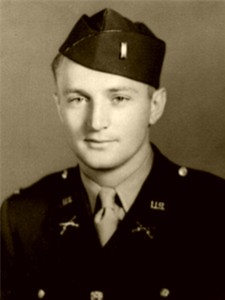James H. Fields, Sr. was born on June 26, 1920, in Caddo, Stephens County, Texas. He was the son of Rollo Burdett Fields and Marguerite Katherine Fresh Fields. He was married to Mathilde Roberts Fields.
Cpt Fields graduated from the first graduating class from Mirabeau Lamar High School in Houston, Texas, in 1939. He attended the University of Oklahoma before he was drafted into the U.S. Army from Houston in February 1942, and by September 27, 1944, was serving as a first lieutenant and a platoon commander in Company A, 10th Armored Infantry Battalion (redesignated from the 10th Armored Infantry Regiment in September 1943), 4th Armored Division.
Captain Fields was the first person decorated in the field with the Medal of Honor by General George S. Patton Jr. and was promoted to captain. After Fields received his Medal of Honor, General Patton sent Fields back to the United States. General Patton stated in his memoir "War as I Knew It," "I told Gaffey I did not want Lieutenant Fields sent to the front again, because it has been my unfortunate observation that whenever a man gets the Medal of Honor or even the Distinguished Service Cross, he usually attempts to outdo himself and gets killed, whereas, in order to produce a virile race, such men should be kept alive."
After the war, he became an independent oil operator in Texas, married, and had four children. He died on June 17, 1970, at age 49. He was buried on June 20 in the Houston National Cemetery, in Houston, Texas.
Medal of Honor citation:
For conspicuous gallantry and intrepidity at risk of life above and beyond the call of duty, at Rechicourt, France. On September 27, 1944, during a sharp action with the enemy infantry and tank forces, 1st Lt. Fields personally led his platoon in a counterattack on the enemy position. Although his platoon had been seriously depleted, the zeal and fervor of his leadership was such as to inspire his small force to accomplish their mission in the face of overwhelming enemy opposition. Seeing that one of the men had been wounded, he left his slit trench and with complete disregard for his personal safety attended the wounded man and administered first aid. While returning to his slit trench he was seriously wounded by a shell burst, the fragments of which cut through his face and head, tearing his teeth, gums, and nasal passage. Although rendered speechless by his wounds, 1st Lt. Fields refused to be evacuated and continued to lead his platoon by the use of hand signals. On one occasion, when two enemy machineguns had a portion of his unit under deadly crossfire, he left his hole, wounded as he was, ran to a light machinegun, whose crew had been knocked out, picked up the gun, and fired it from his hip with such deadly accuracy that both the enemy gun positions were silenced. His action so impressed his men that they found new courage to take up the fire fight, increasing their firepower, and exposing themselves more than ever to harass the enemy with additional bazooka and machinegun fire. Only when his objective had been taken and the enemy scattered did 1st Lt. Fields consent to be evacuated to the battalion command post. At this point he refused to move further back until he had explained to his battalion commander by drawing on paper the position of his men and the disposition of the enemy forces. The dauntless and gallant heroism displayed by 1st Lt. Fields were largely responsible for the repulse of the enemy forces and contributed in a large measure to the successful capture of his battalion objective during this action. His eagerness and determination to close with the enemy and to destroy him was an inspiration to the entire command, and are in the highest traditions of the U.S. Armed Forces.
Source of information: www.findagrave.com, en.wikipedia.org

